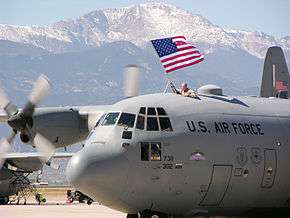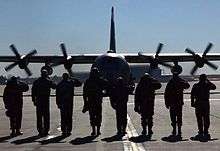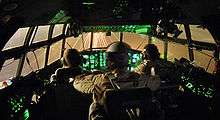302d Airlift Wing
| 302d Airlift Wing | |
|---|---|
 | |
| Active | 28 January 1942 — present |
| Country |
|
| Branch |
|
| Type | Airlift |
| Part of | Air Force Reserve Command |
| Garrison/HQ | Peterson Air Force Base |
| Decorations |
|
| Commanders | |
| Current commander | Colonel Jack H. Pittman Jr. |
| Notable commanders | Joseph J. Nazzaro |

The 302d Airlift Wing (302 AW) is an Air Reserve Component (ARC) of the United States Air Force. It is assigned to the Twenty-Second Air Force, Air Force Reserve Command, stationed at Peterson Air Force Base, Colorado.[1]
Mission
The mission of the 302d AW is to provide superior global reach. The primary operational mission of the 302d AW is tactical airlift and airdrop. The wing also has the specialized mission of Modular Airborne Fire Fighting System (MAFFS), as well as an aeromedical evacuation mission, which was added in April 2008.[1]
Units
- 302d Operations Group (302 OG)
- 731st Airlift Squadron (731 AS)
- 52nd Airlift Squadron (52 AS - Active Duty)
- 302d Maintenance Group (302 MXG)
- 302d Mission Support Group (302 MSG)
History
During World War II, the 302d trained bombardment crews for combat duty.



It conducted airlift training as a reserve corollary unit of 62nd Troop Carrier Wing from June 1949-May 1950, and of the 325th Fighter-Interceptor Wing from May 1950-June 1951. It trained as a reserve troop carrier wing from June 1952. The 302d began flying airlift operations in the mid-1950s and was placed on active duty during the Cuban Missile Crisis of 1962. By the mid-1960s, wing aircraft and crews performed worldwide airlift missions and participated in numerous tactical exercises.

From April 1968 to March 1973 the wing provided AC-119 gunship training for pilots, navigators, flight engineers, and mechanics of USAF active units and personnel from Jordan, Morocco, Ethiopia, and South Vietnam. The wing assumed a rotational airlift task in support of USAF Southern Command from April 1973 through January 1976. Also in April 1973, the wing assumed an aerial spraying mission with UC-123 aircraft, which frequently took wing crews to Central America, the Caribbean, the Azores, North Africa, islands of the Pacific, and to many U.S. points for insect-spraying missions.
Beginning in April 1985, the wing trained to airlift and airdrop troops, equipment, and supplies in a tactical theater. It took part in training and mobility exercises within the United States and to Britain and Panama. It practiced for aeromedical evacuation missions. During the late 1980s and 1990s, the wing transported fire fighters and their equipment and supplies to fight wildfires in western states, delivered relief supplies to hurricane victims, and participated in other humanitarian airlifts and various global contingency operations. The 302d was most recently activated in support of U.S. Central Command operations in Southwest Asia in 2005-2006. In the summer of 2008, two C-130 aircraft and aircrews deployed to Southwest Asia. Other units within the 302d have also deployed, including the 302d Security Forces Squadron, which deployed Airmen in the summer of 2008. Later in the spring of 2009, members of the 302d Civil Engineer Squadron deployed as well. Both units were deployed to Kirkuk Regional Air Base, Iraq.
In October 2009, the 52d Airlift Squadron stood up as an Active-Associate unit under the 302d Operations Group. The unit, a regular Air Force squadron consisting of Active-Duty Airmen, is assigned to the 19th Airlift Wing at Little Rock Air Force Base, Arkansas. Personnel are integrated with reserve members to fly and maintain the wing's assigned aircraft.[2]
The 302d also provides training, crews, and aircraft in cooperation with the U.S. Forest Service to operate MAFFS-equipped C-130s to combat wildfires.[3] It is the only reserve unit that maintains this capability.
Notable Incidents
On 13 May 1995, aircraft 62-1838, callsign "SUMIT38", with six people aboard, caught fire approximately 45 miles east of Mountain Home Air Force Base, Idaho, after ferrying firefighters to Gowen Field at Boise Airport.[4]
The number two engine incorrectly signaled an under temperature reading, causing the flight engineer to enrich the fuel mixture to that engine, leading to an actual over temperature situation. The engine caught fire, and after two attempts by one of the flight crew to quench the fire, the engine reignited causing SUMIT38 to fall 26,000 feet to the ground, killing its six crew members.[5]
The six crew members of SUMIT38 were:
Lieutenant Colonel Robert "Bob" Buckout, Aircraft Commander
First Lieutenant Lance Dougherty, Pilot
Captain Geoff Boyd, Navigator
Chief Master Sergeant "Jimmy" Vail, Flight Engineer
Master Sergeant Jay Kemp, Loadmaster
Staff Sergeant Micheal Lynn Scheideman, Loadmaster
A memorial at Peterson AFB, Colorado, was dedicated to the crew on the 10th anniversary of the crash in May 2005. Several stones, placards and flags are occasionally replaced at the actual crash site, near Bliss, Idaho, by well-wishers, recovery crew, and family members of the crew.[5][6]
Lineage
- Established as 302d Troop Carrier Wing, Medium, on 16 May 1949
- Activated in the Reserve on 27 June 1949
- Re-designated as 302d Troop Carrier Wing, Heavy on 28 January 1950
- Ordered to active service on 1 June 1951
- Inactivated on 8 June 1951
- Re-designated as 302d Troop Carrier Wing, Medium on 26 May 1952
- Activated in the Reserve on 14 June 1952
- Ordered to active service on 28 October 1962
- Relieved from active duty on 28 November 1962
- Re-designated as: 302d Tactical Airlift Wing on 1 July 1967
- Re-designated as: 302d Special Operations Wing on 1 July 1970
- Re-designated as: 302d Tactical Airlift Wing on 2 August 1971
- Inactivated on 1 April 1981
- Activated in the Reserve on 1 April 1985
- Re-designated as: 302d Airlift Wing on 1 February 1992.
Assignments
- Fourth Air Force, 27 June 1949
- Attached to: 62d Troop Carrier Wing, 27 June 1949 – 5 May 1950
- Attached to: 325th Fighter-All Weather Wing, 6 May 1950-
- Western Air Defense Force, 1 August 1950 – 8 June 1951
- Remained attached to 325th Fighter-All Weather [later, 325th Fighter-Interceptor] Wing to 8 June 1951
- First Air Force, 14 June 1952
- Fourteenth Air Force, 25 March 1958
- Second Air Force Reserve Region, 15 August 1960
- Ninth Air Force, 28 October 1962
- Second Air Force Reserve Region, 28 November 1962
- First Air Force Reserve Region, 24 January 1966
- Eastern Air Force Reserve Region, 31 December 1969
- Fourteenth Air Force, 8 October 1976 – 1 April 1981
- Fourth Air Force, 1 April 1985
- Tenth Air Force, 1 July 1994
- Twenty-Second Air Force, 1 April 1997 – present
Components
Groups
- 302d Troop Carrier (later, 302d Operations) Group: 27 June 1949 – 8 June 1951; 14 June 1952 – 14 April 1959; 1 August 1992 – present
- 901st Military (later, 901st Tactical) Airlift Group: 1 July 1972 – 1 April 1974
- 906th Troop Carrier (later, 906th Tactical Airlift) Group: 11 February 1963 – 1 September 1975
- 907th Troop Carrier (later, 907th Tactical Airlift) Group: 11 February 1963 – 1 September 1975
- 908th Troop Carrier (later, 908th Tactical Airlift) Group: 11 February-18 Mar 1963; attached 1–24 October 1971, assigned 25 October 1971 – 1 July 1972
- 910th Troop Carrier (later, 910th Tactical Airlift; 910 Tactical Air Support) Group: 1 July 1966 – 15 February 1970
- 911th Military (later, Tactical) Airlift Group: 25 February 1972 – 1 October 1980
- 912th Troop Carrier Group: 8 January 1965 – 1 July 1966
- 913th Troop Carrier (later, 913th Tactical Airlift) Group: 8 January 1965 – 1 July 1966; attached 30 June-16 Sep 1970, assigned 17 September 1970 – 21 April 1971 (detached 1–21 April 1971)
- 914th Troop Carrier (later, 914th Tactical Airlift) Group: 1 July 1966 – 1 September 1969 (detached 31 July-1 Sep 1969)
- 930th Special Operations Group: 31 December 1969 – 1 June 1970
- 934th Tactical Airlift (later, 934th Airlift) Group: 1 April 1985 – 31 December 1987; 1 August 1992 – 1 October 1994
- 943d Tactical Airlift Group: 1 April 1985 – 1 February 1992
Squadrons
- 1st Combat Crew (later, 1 Tactical Airlift) Training Squadron: 1 July 1968 – 25 March 1973
- 7th Space Operations Squadron: 1 January-1 May 1993
- Combat Crew Training Squadron Provisional, 302d: attached 1 April-1 Aug 1968 (not operational, 1 July-1 Aug 1968)
- 355th Troop Carrier (later, 355th Tactical Airlift) Squadron: 14 April 1959 – 11 February 1963; 1 September 1975 – 1 April 1981
- 356th Troop Carrier (later, 356th Tactical Airlift) Squadron: 14 April 1959 – 11 February 1963; 1 September 1975 – 1 April 1981
- 357th Troop Carrier Squadron: 8 May 1961 – 11 February 1963
- 731st Tactical Airlift (later, 731st Airlift) Squadron: 1 April 1985 – 1 August 1992.
Stations
- McChord AFB, Washington, 27 June 1949 – 8 June 1951
- Clinton County AFB, Ohio 14 June 1952
- Lockbourne (later Rickenbacker) AFB, Ohio, 2 August 1971 – 1 April 1981
- Peterson AFB, Colorado, 1 April 1985 – present
References
![]() This article incorporates public domain material from websites or documents of the Air Force Historical Research Agency.
This article incorporates public domain material from websites or documents of the Air Force Historical Research Agency.
- 1 2 The 302d Airlift Wing
- ↑ New Active Duty squadron joins ranks with Colorado Springs-based AF Reserve C-130 wing
- ↑ MAFFS system description, U.S. Forest Service website
- ↑ "Accident Details". Plane Crash Info. Retrieved 4 July 2010.
- 1 2 "Sumit 38 Crash Site". Waymarking.com. Retrieved 4 July 2010.
- ↑ ""Sumit 38 crash site" Waymark". Joe's Place on the Web. Retrieved 4 July 2010.
- Maguire, Jon A. and the Men of the 27th ATG. Gooney Birds and Ferry Tales: The 27th Air Transport Group in World War II. Atglen, Pennsylvania: Schiffer Publishing, 1998. ISBN 0-7643-0592-1.
External links
| |||||||||||||||||||||||||||||||||||||||||||||||
| ||||||||||||||||||||||||||||||||||

